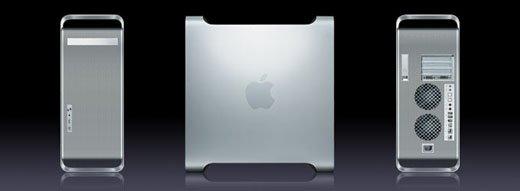No more mysteries: Apple's G5 versus x86, Mac OS X versus Linux
by Johan De Gelas on June 3, 2005 7:48 AM EST- Posted in
- Mac
Introduction
It is a professional 64 bit Dream machine with supersonic speed! It is beautiful. It is about the ultimate user friendliness. It is about a lifestyle. It is a class apart. You guessed it - I am parroting Apple’s marketing.For some reason, the performance of Apple’s gorgeous machines has been wrapped in a shroud of mystery. Yes, you could find a benchmark here and there, with one benchmark showing that the PowerMac is just a mediocre PC while another shows it off as a supercomputer, the unchallenged king of the personal computer world.

If you like a less performance-obsessed article about Apple, OS X and the G5, you should definitely give Anand’s articles in the Mac section on AnandTech a read...
In this article, you will find a pedal to the metal comparison of the latest Xeon DP 3.6 GHz (Irwindale), Opteron 250, Dual G5 2.5 GHz and Dual G5 2.7 GHz.
Scope and focus
Apple’s PowerMac is an alternative to the x86 PC, but we didn’t bother testing it as a gaming machine. Firstly, you have to pay a big premium to get a fast video card – as a standard, you get the ATI Radeon 9650 - even on the high-end PowerMacs. Secondly, there are fewer games available on this platform than on the x86 PC. Thirdly, hardcore gamers are not the ones buying Apples, but rather, creative professionals.So, we focus on workstation and server applications, especially the open source ones ( MySQL, Apache) as Apple is touting heavily on how important their move to an “open source foundation” is.
The 64 bit Apple Machines were running OS X Server 10.3 (Panther) and OS X Server 10.4.1 (Tiger), while our x86 machines were also running a 64 bit server version of a popular Open Source Operating Unix system: SUSE Linux SLES 9 (kernel 2.6.5). We also included an older Xeon 3.06 GHz ( Galatin, 1 MB L3) running SUSE SLES 8 (kernel 2.4.19) just for reference purposes. Some of the workstation tests were done on Windows XP SP2.










116 Comments
View All Comments
Reflex - Friday, June 3, 2005 - link
NT was designed primarily by Dave Cutler, who was one of the guys behind VMS at DEC. NT is not based on Mach and has no relation to it, although it shares some similarities with BSD and VMS.tfranzese - Friday, June 3, 2005 - link
#35, Apple's platform uses HT links (don't ask me specifics).minsctdp - Friday, June 3, 2005 - link
What's with the 24 MB/s memory write time on the Xeon, vs. nearly 2GB/s for the others? Looks bogus.querymc - Friday, June 3, 2005 - link
I'd still like to see a Linux on G5 test. Without one, we still don't know for sure whether the bad performance is due to OS X or the hardware. And it's definitely useful for G5 owners to know whether they can expect Linux to improve server performance.querymc - Friday, June 3, 2005 - link
NT is not built on Mach. NT itself was originally a microkernel-based OS, derived from the design of DEC's VMS OS via the lead architect of both, Dave Cutler. It's currently very monolithic, a bit more than OS X because they stuffed a lot of userspace cruft from Windows 9X in the XP kernel for binary compatibility.Rick Rashid(sp?) was one of the co-developers of Mach, and he went to Microsoft, which is probably what OddTSI is referring to. I don't recall whether he went to research or the OS group, though. Either way, NT has no Mach code and does not share Mach's design.
Netopia - Friday, June 3, 2005 - link
OddTSI (Poster 37)-- Do you have any supporting data for saying that NT is built on Mach?Joe
AluminumStudios - Friday, June 3, 2005 - link
Intersting article. I wish you hadn't left out AfterEffects though because I use it heavily and I'd love to see a comparison between the Mac and x86 on it.OddTSi - Friday, June 3, 2005 - link
There's a semi-big error in your discussion on page 7. NT (and the subsequent Windows OSes based on it) is NOT a monolithic OS. In fact NT is BASED ON MACH. The main developer for the Mach micro-kernel was one of the lead developers of NT.octanelover - Friday, June 3, 2005 - link
I think it would be interesting, on the server side of things, to include Solaris 10 on Opteron in your benchmark list. Seeing as how Solaris is still a major player in the server world it would be nice to see how it fares along with Linux and Mac OSX.By the way, this article, IMHO, is darn near groundbreaking. Excellent work and very illuminating.
exdeath - Friday, June 3, 2005 - link
And before we talk about 10 Gb/sec busses, don't forget the Opteron can have like what 3 HT channels?And Hyper Transport specs allow for 22 GB/sec per channel (11 GB/sec bidirectional?)